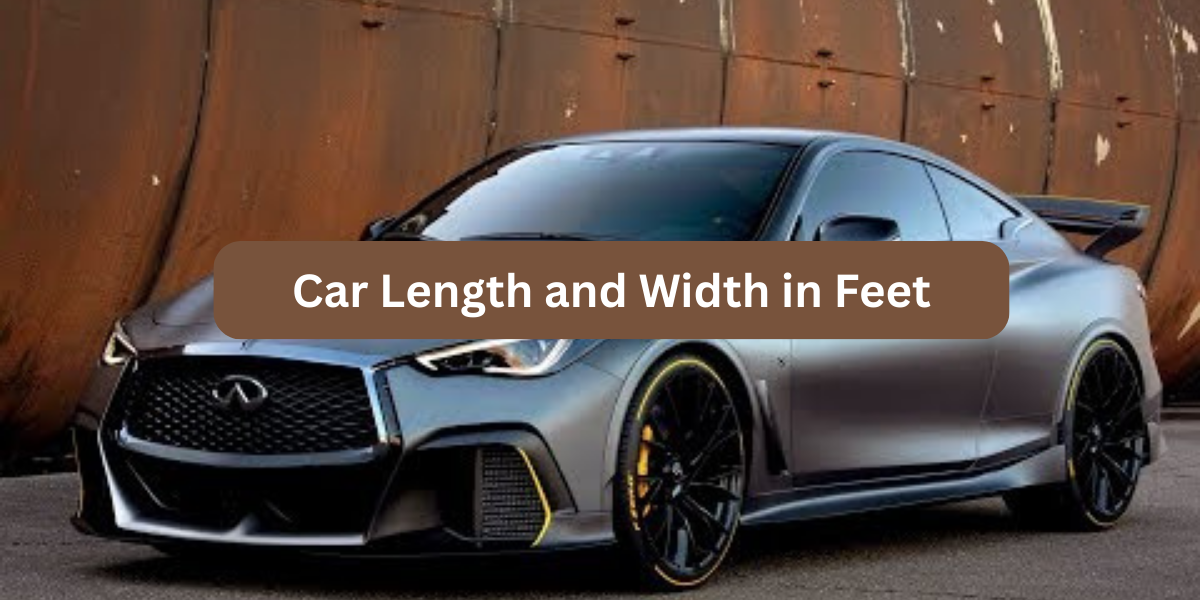Whether you’re shopping for a new car, planning your garage dimensions, or navigating tight parking spots, understanding car length and width in feet is crucial. These dimensions not only affect where and how you can drive or park your car, but they also influence fuel economy, passenger comfort, and overall vehicle performance.
The length of a car usually falls between 10 and 20 feet, depending on the type of vehicle. Small cars like hatchbacks are around 10 to 14 feet long, while larger vehicles like SUVs and trucks can be up to 20 feet or more. As for the width, most cars measure between 5.5 and 7 feet wide, including the side mirrors. The exact size depends on the model and design.
In this guide, we’ll break down the typical length and width of various vehicle types, provide real-world examples, and share tips for measuring and comparing vehicle dimensions accurately. Whether you’re a car enthusiast, a homeowner, or just someone curious about vehicle sizes, this article will give you the clarity you need.
Car sizes can vary depending on the type, but here’s a simple breakdown:
- Compact cars are usually about 10 to 14 feet long, 5.8 to 6 feet wide, and 4.5 to 5 feet tall.
- Midsize cars are typically 14 to 16 feet long, around 6 feet wide, and about 5.6 feet tall.
- Full-size cars are larger, measuring around 16 to 18 feet long, 6 feet wide, and about 4.7 feet tall.
- These are general sizes, and actual dimensions may vary slightly depending on the make and model.
Why Understanding Car Dimensions Matters

Understanding a car’s size isn’t just about trivia. It plays a major role in:
- Garage and driveway planning
- Choosing the right car for your lifestyle
- Navigating tight city streets or parking garages
- Towing or transporting your vehicle
- Vehicle registration and road regulations
Knowing your car’s length and width in feet can save you from costly mistakes—like realizing your new SUV doesn’t fit in your garage after purchase.
Average Car Length and Width in Feet
🚗 Standard Car Dimensions
The average car in the U.S. typically measures:
- Length: 14.7 feet (176.4 inches)
- Width: 6 feet (72 inches)
However, these numbers vary widely based on the vehicle type.
Vehicle Size Comparison by Class
1. Compact Cars
- Length: 13–14.5 feet
- Width: 5.5–6 feet
- Examples: Honda Civic, Toyota Corolla, Hyundai Elantra
Compact cars are great for urban environments thanks to their smaller footprint and improved fuel efficiency.
2. Mid-Size Cars
- Length: 14.5–16 feet
- Width: 6–6.2 feet
- Examples: Toyota Camry, Honda Accord, Nissan Altima
They offer a balance of comfort, performance, and parking ease.
3. Full-Size Sedans
- Length: 16–17 feet
- Width: 6–6.5 feet
- Examples: Chevrolet Impala, Chrysler 300, Ford Taurus
Expect more cabin space and trunk room, but also a higher curb weight.
4. SUVs (Sport Utility Vehicles)
- Length: 15–17 feet (varies by size)
- Width: 6–6.5 feet
Examples:
- Compact SUV: Honda CR-V (15 feet)
- Mid-Size SUV: Ford Edge (16 feet)
- Full-Size SUV: Chevrolet Tahoe (17.5 feet)
SUVs range dramatically, so always check individual specs.
5. Pickup Trucks
- Length: 17–22 feet
- Width: 6.5–7 feet (wider with towing mirrors)
- Examples: Ford F-150, Ram 1500, Toyota Tundra
Trucks are the longest vehicles in most neighborhoods, often requiring special parking considerations.
6. Minivans
- Length: 16.5–17 feet
- Width: 6.3–6.6 feet
- Examples: Chrysler Pacifica, Honda Odyssey, Toyota Sienna
Family-oriented, with generous interior space but a larger turning radius.
How to Measure a Car’s Length and Width in Feet
Want to measure your car dimensions accurately? Follow these steps:
✅ Tools You’ll Need:
- Tape measure (25 ft+)
- Notebook or smartphone for recording
🔍 Steps:
Length:
- Place the tape measure at the front most point (bumper).
- Extend it to the rear bumper.
- Record the measurement in inches, then divide by 12 to convert to feet.
Width:
- Measure the widest part of the car, typically the side mirrors.
- For body-only width, exclude mirrors.
- Again, convert inches to feet.
Real-World Examples of Car Length and Width
| Vehicle | Length (feet) | Width (feet) |
|---|---|---|
| Honda Civic | 14.8 ft | 5.9 ft |
| Toyota Camry | 16 ft | 6.1 ft |
| Ford F-150 | 19.4 ft | 6.8 ft |
| Chevrolet Suburban | 18.9 ft | 6.9 ft |
| Tesla Model 3 | 15.5 ft | 6.1 ft |
Note: Dimensions may vary slightly depending on trim level or optional accessories.
Tips for Garage and Parking Fit
If you’re planning a garage renovation or building a new one, here’s what to consider:
🏠 Standard Garage Sizes:
| Garage Type | Width (feet) | Depth (feet) |
|---|---|---|
| Single-car | 12 ft | 20–24 ft |
| Double-car | 20–24 ft | 20–24 ft |
| Tandem garage | 12–16 ft | 36–40 ft |
🚗 Parking Tips:
- Always leave at least 2 feet of clearance in front and behind the car.
- Mirrors typically require 1–1.5 feet of side clearance.
- Consider foldable mirrors for tight garages.
Common Questions About Car Length and Width
❓Can you legally park a pickup truck on a residential street?
- It depends on local ordinances. Many cities require vehicles to fit fully within marked spaces—pickup trucks exceeding 20 feet may get cited or towed.
❓Do car dimensions include side mirrors?
- Not always. Manufacturer specs often exclude mirrors unless noted. For real-world space planning, always include them in your measurements.
❓Why do European cars tend to be smaller?
- European cities often have narrower streets and tighter parking. Fuel efficiency and taxes based on engine size and emissions also influence car design there.
Car Width vs. Car Height: What Matters More?
While height affects vehicle stability (especially in SUVs and vans), width impacts garage fit and maneuverability far more. A wider car may be more stable and offer better interior space, but it also poses a greater challenge in urban driving or tight driveways.
Secondary Considerations When Choosing a Vehicle
Besides length and width, you should also think about:
- Turning radius (ease of U-turns and city driving)
- Wheelbase (impact on ride comfort and handling)
- Curb weight (influences fuel efficiency and towing)
Conclusion
Understanding a car’s length and width in feet goes beyond technical specs it’s about making informed choices that affect daily convenience, safety, and long-term satisfaction. Whether you’re buying a new vehicle, constructing a garage, or just want to park with confidence, these dimensions give you the practical knowledge to do so.
Before making your next move, take a moment to measure your space, compare it with your car, and plan accordingly. A few extra inches can make a big difference.

